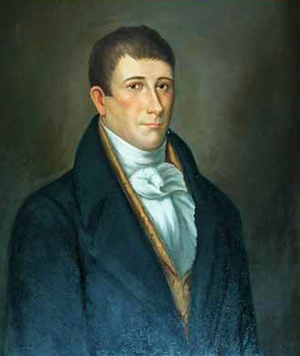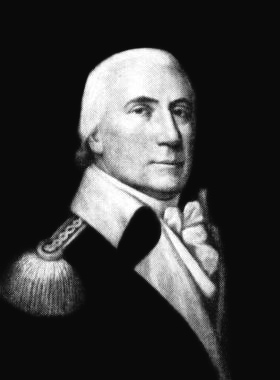
Abner Nash was the second Governor of the U.S. state of North Carolina between 1781 and 1782, and represented North Carolina in the Continental Congress from 1782 to 1786.

The North Carolina State Treasurer is a statewide elected office in the U.S. state of North Carolina responsible for overseeing the financial operations of state government. The current state treasurer is Dale Folwell.

The North Carolina General Assembly of 1777 met in two sessions in New Bern, North Carolina, from April 7 to May 9, 1777, and from November 15 to December 24, 1777. This was the first North Carolina legislature elected after the last provincial congress wrote the first North Carolina Constitution. This assembly elected Richard Caswell as the state's first constitutional governor.
The North Carolina General Assembly of 1778 met in three sessions in three locations in the years 1778 and 1779. The first session was held in New Bern from April 14 to May 2, 1778; the second session in Hillsborough, from August 8 to August 19, 1778; the third and final session in Halifax, from January 19 to February 13, 1779.
The Edenton District Brigade was an administrative division of the North Carolina militia during the American Revolutionary War (1776–1783). This unit was established by the North Carolina Provincial Congress on May 4, 1776, and disbanded at the end of the war.
The New Bern District Brigade was an administrative division of the North Carolina militia during the American Revolutionary War (1776–1783). This unit was established by the North Carolina Provincial Congress on May 4, 1776, and disbanded at the end of the war.
William Caswell was an American politician, lawyer, and planter. Besides service on state court benches, he represented Dobbs County in the North Carolina House of Commons from 1779 to 1784. He was also a senior officer who commanded militia during the American Revolution.
Benjamin Exum (1725-1789) was an officer in the North Carolina militia during the American Revolution and a Senator in the North Carolina General Assembly from Dobbs County.
The Dobbs County Regiment was a unit of the North Carolina militia that served during the American Revolution. The regiment was one of thirty-five existing county militias that were authorized by the North Carolina Provincial Congress to be organized on September 9, 1775. All officers were appointed with commissions from the Provincial Congress. On May 4, 1776, the regiment was placed under the command of the New Bern District Brigade commanded by Brigadier General Richard Caswell. The regiment was active until the end of the Revolutionary War in 1783 and was engaged in twelve known battles and skirmishes in North Carolina, South Carolina and Georgia.
The Wayne County Regiment was a unit of the North Carolina militia that served during the American Revolution. The North Carolina General Assembly created Wayne County and its regiment of militia out of part of Dobbs County and its regiment of militia on November 2, 1779. The officers were appointed and commissioned by the governor of North Carolina. The regiment was disbanded at the end of the war.
The North Carolina General Assembly of 1780-1781 was the fourth elected legislative body of the State of North Carolina. The assembly consisted of a Senate and House of Commons that met in three sessions in at least two locations in the years 1780 and 1781. Each of the existing 50 North Carolina counties were authorized to elect one Senator and two members of the House of Commons. In addition, six districts also elected one House member each. The first two sessions were probably held in New Bern, North Carolina in April and September 1780. The third session met in Halifax from January 27, 1781 – February 13, 1781.
Thomas Benbury was a revolutionary leader in the early formation of the State of North Carolina. He was a member of the North Carolina Provincial Congress, a member of the North Carolina House of Commons from 1776 to 1782, Speaker of the House of Commons, and an officer in the Chowan County Regiment during the American Revolution.
Colonel John Sheppard was a Revolutionary War soldier and commander of the Wayne County Regiment of the North Carolina militia. His father, Abraham Sheppard was a planter, politician, and commander of the Dobbs County Regiment and 10th North Carolina Regiment. He also had a brother, Abraham Sheppard, Jr., who served with John in the Dobbs County Regiment.
The North Carolina General Assembly of 1783 was the state legislature that convened in Hillsboro, North Carolina from April 18, 1783, to May 17, 1783. Members of the North Carolina Senate and the North Carolina House of Commons were elected by eligible North Carolina voters. This was the last assembly to meet during the American Revolution. Much of their time was devoted to taking care of the North Carolina soldiers that fought in the war.

The Fifth North Carolina Provincial Congress was the last of five extra-legal unicameral bodies that met beginning in the summer of 1774. They were modeled after the colonial lower house. These congresses created a government structure, issued bills of credit to pay for the movement, organized an army for defense, wrote a constitution and bill of rights that established the state of North Carolina, and elected their first acting governor in the fifth congress that met in 1776. These congresses paved the way for the first meeting of the North Carolina General Assembly on April 7, 1777 in New Bern, North Carolina. The Fifth Congress met in Halifax from November 12 to December 23, 1776. Richard Caswell served as president, with Cornelius Harnett as vice-president.

The Third North Carolina Provincial Congress was the third of five extra-legal unicameral bodies that met between 1774 and 1776 in North Carolina. They were modeled after the colonial lower house. These congresses created a government structure, issued bills of credit to pay for the movement, and organized an army for defense, in preparation for the state of North Carolina. These congresses paved the way for the first meeting of the North Carolina General Assembly on April 7, 1777 in New Bern, North Carolina.
The North Carolina General Assembly of 1835 met in Raleigh from November 16, 1835 to December 22, 1835. The assembly consisted of the 137 members of the North Carolina House of Commons and 65 senators of North Carolina Senate elected by the voters in August 1835. This was the last assembly elected before the amendments to the Constitution of North Carolina from the North Carolina Constitutional Convention of 1835 took effect. Thus, the House of Commons included representatives from towns and the number of members of the house was greater than 120. William H. Haywood, Jr was elected speaker of the House of Commons and Charles Manley was elected clerk. William D. Mosely was elected President of the Senate and William J. Cowan was elected Clerk. Richard Dobbs Spaight, Jr. was elected the Governor by the assembly and served from December 10, 1835 to December 31, 1836. He was the last governor of North Carolina to be elected by the General Assembly.
The North Carolina General Assembly of October 1784 met in New Bern from October 25, 1784 to November 26, 1784. The assembly consisted of the 116 members of the North Carolina House of Commons and 55 senators of North Carolina Senate elected by the voters on August 20, 1784. As prescribed by the 1776 Constitution of North Carolina the General Assembly elected Richard Caswell as Governor of North Carolina and members of the Council of State.
The North Carolina General Assembly of 1785 met in New Bern from November 18, 1785 to December 29, 1785. The assembly consisted of the 114 members of the North Carolina House of Commons and 54 senators of North Carolina Senate elected by the voters on August 19, 1785. During the 1785 session, the legislature created Rockingham County. As prescribed by the 1776 Constitution of North Carolina the General Assembly elected Richard Caswell to continue as Governor of North Carolina and members of the Council of State.













